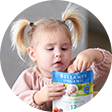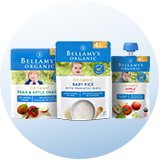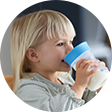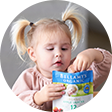Recommended Daily Intake for Toddlers Aged 3-4 Years
How your child eats as a toddler will have a striking impact on their health throughout childhood, adolescence, and adulthood. Children require a variety of nutrient-dense foods such as fresh fruit, vegetables, whole grains, meat and fish, as well as adequate calories that will help them to grow and develop properly. Childhood is a time of critical growth in which proper nutrition is absolutely necessary. When nutrition is neglected, be it by lack of food or poor eating habits, toddlers become prone to both short-term and long-term health issues and diseases. Toddlers afflicted by continual poor nutrition are at greater risk of obesity, mental and emotional problems, and failure to thrive as they should. According to the Children’s Defense Fund, children who do not have access to proper nutrition are more likely to suffer from psychological disorders, such as anxiety or learning disabilities. They can struggle to adapt normally to certain situations, and are vulnerable to multiple developmental impairments. Please note that the following should be seen as general advice for a balanced diet of toddlers aged 3-4 years, referencing the Australian Dietary Guidelines. For specific advice, please consult your healthcare professional.
A toddler’s requirements
 The time between a three and four-year-old’s birthday is a period of rapid social, intellectual and emotional growth. It’s also characterised by a slowdown in growth-rate, which could explain why your child suddenly has a reduced appetite. Toddlers of this age require less food than they did as a baby, and their small stomachs mean that grazing is still a crucial part of their day. Children have an in-built hunger alert and satiety mechanism, so will naturally eat accordingly. If your child skips a meal, don’t panic - they’ll eat when they want to. The Dietary Guidelines for Children and Adolescents in Australia recommends small, frequent, nutritious and energy-dense foods from a variety of food groups. While it is normal to eat more of some foods on certain days and less on others, eating as close to the recommended guidelines will ensure your toddler is getting an adequate amount of energy and nutrients in their overall diet. The Australian Daily Intake Guide or %DI is a set of reference values for an acceptable intake of nutrients, including:
The time between a three and four-year-old’s birthday is a period of rapid social, intellectual and emotional growth. It’s also characterised by a slowdown in growth-rate, which could explain why your child suddenly has a reduced appetite. Toddlers of this age require less food than they did as a baby, and their small stomachs mean that grazing is still a crucial part of their day. Children have an in-built hunger alert and satiety mechanism, so will naturally eat accordingly. If your child skips a meal, don’t panic - they’ll eat when they want to. The Dietary Guidelines for Children and Adolescents in Australia recommends small, frequent, nutritious and energy-dense foods from a variety of food groups. While it is normal to eat more of some foods on certain days and less on others, eating as close to the recommended guidelines will ensure your toddler is getting an adequate amount of energy and nutrients in their overall diet. The Australian Daily Intake Guide or %DI is a set of reference values for an acceptable intake of nutrients, including:
- Energy
- Protein
- Fat
- Saturated Fatty Acids
- Carbohydrate
- Sodium (Salt)
- Sugars
- Dietary Fibre
The Daily Intake Guide can make healthy eating easier by providing a better view of what’s in your food and drinks, but bear in mind that this is based on an average adult diet of 8,700 kilojoules. A toddler’s average kilojoules are more likely around 7,000 kilojoules. It’s recommended to study both of these guides, and garner a good understanding of what ‘healthy eating’ is.
Toddler servings
 Toddlers need a diet made up of foods from the four main food groups (fruits & vegetables, starchy foods, dairy foods and protein), served in the correct portion sizes and in the correct balance. Aim for between 1,000 and 1,400 calories per day and keep up a steady intake of water. Your toddler’s diet should:
Toddlers need a diet made up of foods from the four main food groups (fruits & vegetables, starchy foods, dairy foods and protein), served in the correct portion sizes and in the correct balance. Aim for between 1,000 and 1,400 calories per day and keep up a steady intake of water. Your toddler’s diet should:
- Aim for 2.5-4 serves of vegetables and legumes per day.
- Aim for 1-1.5 serves of fruit per day.
- Aim for 4 serves of grains per day.
- Aim for 2 serves of meat, fish, eggs or nuts per day.
- Aim for 2 serves of milk, yoghurt, cheese per day.
Vegetables and legumes Vegetables can be eaten raw, grated, sliced, stir-fried, steamed or boiled, and mixed together with a number of foods, herbs or spices to make them more appealing to toddlers. A standard serve is about 75g, and could be:
- ½ cup cooked broccoli, spinach, carrots, pumpkin etc.
- 1 cup leafy or raw salad vegetables
- 1 medium tomato
- ½ cup sweetcorn
- ½ sweet potato.
Legumes are dried fruit contained within a shed or pod and are famous for their protein content, as well as minerals and fibre. A serve could be:
- ½ cup canned beans (reduced salt)
- ½ cup peas
- ½ cup lentils
- 4-5 snow peas.
Fruits  Fruits provide essential vitamins and minerals. A serve of fruit could be:
Fruits provide essential vitamins and minerals. A serve of fruit could be:
- 1 small apple.
- 1 cup sliced peaches
- 1 large banana
- 20 seedless grapes
- 1 large orange
- 8 strawberries
- ½ cup sultanas
Grains  Children need around 4 servings of grains per day, depending on their age, activity level and gender. At least half of these grains should be whole grains - in other words not stripped of bran and germ layer. A serve of grains could be:
Children need around 4 servings of grains per day, depending on their age, activity level and gender. At least half of these grains should be whole grains - in other words not stripped of bran and germ layer. A serve of grains could be:
- 1 whole wheat mini bagel
- 1 slice whole wheat bread
- ½ cup cooked bulgur wheat
- 5 whole wheat crackers
- 1 whole wheat muffin
- 1 buckwheat pancake
- ½ cooked brown rice.
Meat, fish, eggs, nuts  These foods are a rich source of protein (needed for lots of functions throughout the body) as well as vitamin B12 and iron. Getting an adequate amount of lean protein in your toddler’s diet can produce a myriad of health benefits. A serve of meat, fish, eggs or nuts could be:
These foods are a rich source of protein (needed for lots of functions throughout the body) as well as vitamin B12 and iron. Getting an adequate amount of lean protein in your toddler’s diet can produce a myriad of health benefits. A serve of meat, fish, eggs or nuts could be:
- 1 ounce cooked beef or chicken
- 2 tablespoons ground meat (mince)
- 1 small can tuna
- ½ salmon steak
- 1 egg
- 12 almonds
- ½ ounce mixed seeds
- 1 tablespoon peanut butter.
Milk, yoghurt, cheese  It is essential that a toddler gets the recommended amount of dairy they need for healthy teeth and bones. Dairy contains a trio of minerals - calcium, potassium and magnesium - and should be a part of your toddler’s nutrient-rich, balanced diet. A serve of milk, yoghurt or cheese could be:
It is essential that a toddler gets the recommended amount of dairy they need for healthy teeth and bones. Dairy contains a trio of minerals - calcium, potassium and magnesium - and should be a part of your toddler’s nutrient-rich, balanced diet. A serve of milk, yoghurt or cheese could be:
- 1 cup low-fat milk
- ¼ cup evaporated milk
- 1 small yoghurt pot
- ⅓ cup grated cheese
- ½ cup ricotta cheese
- 2 cups cottage cheese.
A toddler’s habits
 The time between three and four years of age can be challenging for many parents and caregivers. Toddlers of this age are exploring their independence, and realising they are separate beings from the adults in their life. They enter into power struggles with their caregivers, and are determined yet fearful of new experiences. Recognising the needs of both parent and child in the complex process of eating and mealtimes is important when building a healthy parent-child feeding relationship. A good understanding of how a toddler approaches eating will make mealtimes a great deal easier. Toddlers like to touch, see, listen, smell and taste their foods. Food is of great interest to them, but not always as a food source that will feed their little tummies. Sometimes, they simply want to discover or play with their food. Inconsistency is a common feature in toddlers, and one day they might love Vegemite only to hate it the next. They might feed themselves for a few days before deciding they cannot possibly eat without your spoon feeding them. This is perfectly normal, and something you may have to get used to. Inconsistency as well as a need for ritual is a normal part of the transition from infancy to childhood. Toddlers also have a limited attention span, so don’t get too cross if they don’t want to sit at the dinner table for too long. Stimulation is the key to keeping them there, as is the removal of common distractions. As toddlers love to imitate those around them, use the dinner table to show your enjoyment and acceptance of food and the joy that healthy eating can bring. As for our number one tip - relax! As long as you offer your toddler a range of healthy foods, they’ll hopefully eat it. Trust their judgement, and try not to make meal and snack times a forced thing. Food should be enjoyed, not feared and providing good meal choices this will hopefully instill good eating habits later on in life.
The time between three and four years of age can be challenging for many parents and caregivers. Toddlers of this age are exploring their independence, and realising they are separate beings from the adults in their life. They enter into power struggles with their caregivers, and are determined yet fearful of new experiences. Recognising the needs of both parent and child in the complex process of eating and mealtimes is important when building a healthy parent-child feeding relationship. A good understanding of how a toddler approaches eating will make mealtimes a great deal easier. Toddlers like to touch, see, listen, smell and taste their foods. Food is of great interest to them, but not always as a food source that will feed their little tummies. Sometimes, they simply want to discover or play with their food. Inconsistency is a common feature in toddlers, and one day they might love Vegemite only to hate it the next. They might feed themselves for a few days before deciding they cannot possibly eat without your spoon feeding them. This is perfectly normal, and something you may have to get used to. Inconsistency as well as a need for ritual is a normal part of the transition from infancy to childhood. Toddlers also have a limited attention span, so don’t get too cross if they don’t want to sit at the dinner table for too long. Stimulation is the key to keeping them there, as is the removal of common distractions. As toddlers love to imitate those around them, use the dinner table to show your enjoyment and acceptance of food and the joy that healthy eating can bring. As for our number one tip - relax! As long as you offer your toddler a range of healthy foods, they’ll hopefully eat it. Trust their judgement, and try not to make meal and snack times a forced thing. Food should be enjoyed, not feared and providing good meal choices this will hopefully instill good eating habits later on in life.































